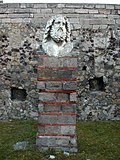Temple of Jupiter (Pompeii)

The Temple of Jupiter, Capitolium, or Temple of the Capitoline Triad was a temple in the Roman city of Pompeii in Italy. At the beginning this temple was dedicated to Jupiter alone, it was built in the mid 2nd century BC at the same time as the temple of Apollo was being worked on - this was the era at which Roman influence over Pompeii was at its height and so Roman Jupiter beat out the Greek Apollo and Jupiter(, Juno, and Minerva) in towns newly taken over by the Romans. This was also true for Pompeii, where the Temple of Jupiter that was already there was enlarged and made more Roman when the Romans took over.
| Wikimedia Commons has media related to Lua error in Module:Commons_link at line 62: attempt to index field 'wikibase' (a nil value).. |
Pompeii was taken over by the Romans beginning in 310 BC. It was still allowed to mostly run itself, however, until the Italic Revolt against Rome at the beginning of the 1st century BC.
The building style of the town was largely borrowed from the Greeks, but Roman rule would soon lead to changes in this style. As opposed to the previous Samnite rulers of Pompeii, the Romans thought that the building style was very important in religious as well as everyday life. Pompeii was changed into a much more public and open place. Public buildings and spaces would eventually be able to be found all over the city.
The temple had been built in 150 BC to be a very noticeable part of the forum, and it became Pompeii's main temple after Rome took over. The inside of the temple housed the main room of the temple, which held the statues of Jupiter, Juno, and Minerva, and which only the priests were allowed to enter.
In 62 an earthquake shook the city of Pompeii, destroying much of the Temple of Jupiter. After this, the much smaller Temple of Jupiter Meilichios became the main place of worship to Jupiter and his group of three (triad). The first Temple of Jupiter was still waiting to be fixed when Mount Vesuvius erupted in 79, burying the town of Pompeii under lava and ash. The hollow temple can still be seen in Pompeii today.
References
- “Jupiter.” Encyclopedia of the Roman Empire. Matthew Bunson. Facts on File, Inc., 1994. Page 221.
- “Pompeii.” The Oxford Classical Dictionary, Third Edition Revised. Edited by Simon Hornblower and Anton Spawforth. Oxford University Press, 2003. Pages 1214-1215.
- Description and Analysis of Roman Cities - Pompeii Archived 2010-02-04 at the Wayback Machine
- Temples of Pompeii, including photographs of excavated temples
- Temples and Buildings of Pompeii, including rough map of Pompeii Archived 2009-03-27 at the Wayback Machine
- Photograph and Mapped Location of Temple of Jupiter, Pompeii
Temple Of Jupiter (Pompeii) Media
Archived 2009-08-14 at the Wayback Machine




